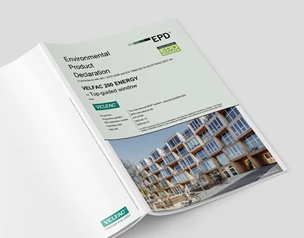Download VELFAC EPD's
Get our Environmental Products Declarations for the production stage (A1–A3) of a VELFAC top-guided window with reference dimensions of 1230x1480mm. The report provides information about its impact on the environment, such as global warming potential, smog creation, ozone depletion and water pollution.
Everything you need to know about VELFAC EPD
What is an EPD?
The report:
- Declares environmental impact for a specific material per unit or per m2
- Is based on an LCA (Life Cycle Assessment) of the products
- Follows the EPD standard EN15804:2013+A2:2019
- Must be 3rd party verified according to ISO 14025
- Valid for a 5-year period
How can you compare EPDs?
VELFAC product specific EPDs
We have produced 2 EPDs that reflect our overall window systems. In both cases, the starting point is a top-guided window with the reference dimensions 1230x1480mm:
- VELFAC 200 ENERGY
- VELFAC Ribo (wood/aluminium)
The product-specific EPDs from VELFAC cover:
- The modules: A1-A3, C1-C4 & D
- 1 m 2declared unit based on the reference window
The EPDs do not cover the modules: B1-B7 (use phase).
How to read and use the EPDs?
When calculating the carbon footprint of a whole building, usually is considered a life span of about 50 years.
The table below has been extrapolated from the VELFAC EPD documentation for a top-guided VELFAC 200 ENERGY window in wood/aluminium. The GWP ( Global warming potential) figure is an expression of how much kg CO 2 our sample window generates in the construction phase (manufacturing, disposal and recycling).

Terminology
EPD: Environmental Product Declaration - environmental product declaration that describes a building product's environmental impact
LCA: Life Cycle Assessment. A method that calculates the potential environmental impacts of a building or a product.
Equivalents: Conversion term so that the environmental impact of different emissions can be compared.
GWP: Global Warming Potential. The GWP index expresses the climate impact over a number of years in CO 2.
PCR: A product category rule (PCR) is a set of guidelines that determine what data should be gathered and how it will be evaluated when conducting the life cycle assessment (LCA) of a product.




